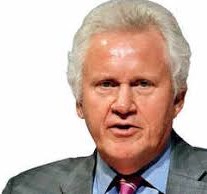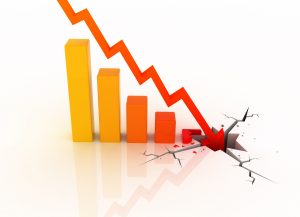 You may be aware of the serious business challenges GE is experiencing and the well storied decline of this industrial icon over the past several years. How could this happen at GE? And what really happened at GE? It’s not what most people think. There is the party line, and then there is a deeper, more revealing view.
You may be aware of the serious business challenges GE is experiencing and the well storied decline of this industrial icon over the past several years. How could this happen at GE? And what really happened at GE? It’s not what most people think. There is the party line, and then there is a deeper, more revealing view.
The Party Line
By most accounts there was a long string of financial missteps that eroded profits, shareholder value and the stock price. “For example, from 2010 through 2014, when oil prices hovered around $100 a barrel, GE bought at least nine businesses in the oil and gas industry. Then, in 2016, with prices down by half, it agreed to combine its oil and gas unit with Baker Hughes…” Stock prices for the new unit, of which GE was the major shareholder, fell and never recovered. This stoked GE’s reputation as a company that bought high and sold low.
Another example was GE Capital. Sometimes referred to as part of ‘the house that Jack built’, GE Capital grew assets to $637 billion by 2008 “before being strangled by the impact of the credit crunch when the market for commercial paper all but dried up.” During his tenure, “Immelt expanded the business by adding over $250 billion of debt to it, until it accounted for 55% of GE’s profit in 2007. He also allowed it to take greater risks, notably by making direct equity investments in commercial real estate. That worked great until the crisis, when most of GE Capital’s profit evaporated. Immelt cut GE’s dividend for the first time since the Great Depression and had to ask Warren Buffett for $3 billion right away. GE Capital never recovered, and when Immelt announced plans to dismantle it in 2015, investors cheered.”
There are many other examples of GE’s financial missteps, as well as some success stories, but the party line is clear. As a consequence of these missteps, GE’s stock price has fallen approximately 80% in the past two years. In a major blow, GE, an original member of the Dow Jones industrial average, was taken out of the average in June 2018.
 Who is Being Blamed?
Who is Being Blamed?
Most analysts and authors point the finger at the company’s leaders. That assertion is a surprising turnaround at GE. For years Jack Welsh, legendary CEO, was the poster child of what he and many others characterized as strong and innovative management practices. Until recently criticism of Welch would have been unthinkable. In his November 2017 article in CNN Business, Matt Egan remarked, “He was a larger-than-life force whom Fortune named “manager of the century” in 1999. That aura has since been punctured.”
 Jeff Immelt, a long-time GE executive and Welch’s successor, carried many of Welsh’s management practices forward. He was also celebrated during a good portion of his tenure. Now many blame both Welsh and Immelt for the company’s dire situation. Others have been tasked with fixing it but so far the needle hasn’t moved much. After barely a year at the helm, Immelt’s successor, John Flannery, was pushed out by the Board. Now Larry Culp, former CEO of Danaher, a GE competitor, will take a turn at putting the pieces back together. But do we really know what happened and why? Was the problem the financial blunders or something deeper and more inherent at GE?
Jeff Immelt, a long-time GE executive and Welch’s successor, carried many of Welsh’s management practices forward. He was also celebrated during a good portion of his tenure. Now many blame both Welsh and Immelt for the company’s dire situation. Others have been tasked with fixing it but so far the needle hasn’t moved much. After barely a year at the helm, Immelt’s successor, John Flannery, was pushed out by the Board. Now Larry Culp, former CEO of Danaher, a GE competitor, will take a turn at putting the pieces back together. But do we really know what happened and why? Was the problem the financial blunders or something deeper and more inherent at GE?
Why GE?
I chose GE as an example in this article for a few important reasons. First, given its amazing history and reputation, it seems so unlikely that such a decline would ever befall GE and, further, that the celebrated company leaders would be faulted by so many. The point is, if it can happen to GE, it can happen to any business. Consequently, GE makes a good example.
Second, this story is a great example of how we focus on outcomes without really understanding what is “broken” within a company. We accept the traditional management wisdom as the beginning and end of the story. However, traditional wisdom is more about what happened. It says little about why it happened. I’d like to shed some light in this article on what really happened at GE.
Third, as I reveal a new perspective on why this all happened, I connect some dots and put all of this into a larger context. Specifically, you will see how GE is being affected by the same monumental trends that are plaguing all businesses in this Fourth Industrial Revolution. To be clear, these trends are not the core problem. They are exacerbating the core problem. While the core problem is serious, it hasn’t been life threatening for businesses until recently when these trends ramped up.
That clarity is very important because your business, like GE, is subject to those trends as well as the core problem. Please don’t think for a minute that this kind of crisis can’t happen in your business. Big or small, we are all affected. In this article I will explain how this worked at GE so you can better understand your own situation and what you can do about it.
GE’s Outcomes Are Not the Root Causes

The popular press and our traditional wisdom have become accustomed to judging the performance of companies and CEOs based on surface-level events such as the financial missteps discussed above. Fair enough. CEOs are accountable for company performance. The problem, however, is that we also assume that these missteps are the root causes of the problems. That’s not the case at all.
CEOs don’t operate in a vacuum. They are surrounded by their staff, advisers and the companies they have helped create. Any major decision like an acquisition is the culmination of many internal conversations, actions and probably debates. The company culture creates the organizational attitude and orientation for the whole process. Organizational structure, operational mechanisms and the agendas of both the company and the individuals involved come into play. In short, the whole system is involved. What makes the system churn out a decision that will eventually be called a financial misstep? Find the answer, and you have found the root causes.
What Were the Root Causes?
The root causes of GE’s financial missteps as well as its currently perilous business circumstance were things that were “broken” and/or poorly designed in the GE “enterprise system.” These “enterprise elements” include things like organizational structure, business processes, departmental and individual role definitions (or lack thereof), decision making authorities and processes, and incentives. I describe these elements and their interplay at length in my new book. Suffice it to say that poorly designed or inadequate enterprise elements create negative energy that drags down the business and its ability to function well.
There is one enterprise element that overshadows all others. That element is the company culture. There is an old Zen saying that “How you do anything is how you do everything.” It turns out that has some truth for businesses as well. All of the other enterprise elements are designed and developed within the framework and context of the company culture. That makes it extremely important and influential. One can find indicators of the culture at GE even in public stories. Let’s take a look at three of those stories.
A Culture of Individualism and Competition

There are many accounts of the dysfunctional culture that Welsh created at GE. For example, in his book, Leaders Eat Last, Simon Sinek wrote, “The personality and values of the person at the top set the tone of the culture. A man who has penned five books about leadership and put his own face on the cover of all them, Welch, it’s fair to say, liked his celebrity . . . and the culture of his company followed. In Jack Welch’s GE, people were pitted against each other. They were driven to do whatever they could to make themselves look good . . . Being number one was all that mattered.” This type of culture in a company breeds internal competition and conflict, which are both highly damaging and wasteful. Such a culture makes healthy collaboration, needed for good decision making and strong business outcomes, almost impossible. In this environment, people must watch their backs.
Six Sigma
Six Sigma is a revered management practice at GE, driven by a culture that values production over people. Unfortunately, it may have done more damage than good. In a Financial Times article, Who is Responsible for the Mess at GE?, Andrew Hill wrote, “One means of achieving management perfection at GE was Six Sigma. This management technique, invented at Motorola in the 1980s, aims to eliminate defects in production processes (attaining a close-to-perfect “six sigma” level of quality). Intensive training of workers to “black belt” level gave it a cultish feel, and it was easily lampooned. But Mr. Welch insisted Six Sigma should be applied across GE from the mid-1990s.”
Mr. Hill was asserting that the intense use of Six Sigma at GE didn’t come close to creating management perfection. I agree. While Six Sigma can be an effective approach for production-oriented process improvement, it’s based on traditional management practices that grew up during the first industrial revolution. During that period, standardization, efficiency and predictability were the goal and people were viewed as little more than cogs in the machine.
Six Sigma, in my experience, pays too little attention to the characteristics and variability of people. It also encourages point solutions for individual processes while largely ignoring the health of the whole system and how those pieces fit into it. Furthermore, I’ve noticed that companies like GE that fervently embrace Six Sigma often develop an elitist attitude. As a result, the enterprise system suffers while managers enjoy a false sense of security that things are OK, or even better than OK. Such was the case at GE.
Work Out
Add up all of the negative energy produced day in, day out by all of the dysfunctional enterprise elements and you have a very dysfunctional GE.

This dysfunction often presented itself as what people called bureaucracy. Ironically, under Welch’s leadership, GE developed a method of “busting bureaucracy.” It was called Work Out. The idea behind this methodology was to put senior decision makers at the front of a room and put them on the spot with suggestions for improvement from the audience. The decision makers had to respond with “Yes”, “No”, or “I’ll get back to you at a specific time.”
Certainly some good came out of it, and other companies adopted the method. However, having experienced a Work Out session myself, it seems clear that it works best for simple point solutions like financial signing authority limits. Anything more complicated is too much to process on the spot. Thus, Work Out gets around dysfunctional bureaucracy but never really fixes it. Ironically, the need for a methodology like Work Out highlights the presence of a very dysfunctional bureaucracy in the first place.
Buffers
The dysfunction that permeated the GE enterprise made it vulnerable to changes in external conditions that could add pressure to the system. However, for years GE had some built-in buffers that guarded it against such external shifts. GE’s Financial Services Division was perhaps its greatest buffer.
In a February 2018 article in Bloomberg Business Week Richard Clough wrote, “In the hands of GE’s financial executives and tax lawyers, earnings from this division had special powers. GE Capital could borrow money in the U.S. to fund offshore businesses in countries where corporate taxes were much lower (or nonexistent), then turn around and use the interest charges on those loans to offset the income from GE’s onshore manufacturing businesses, making its U.S. tax bills disappear. And unlike a factory, GE Capital’s highly liquid assets could be bought or sold at the ends of quarters to ensure the smoothly rising earnings that investors loved.” Ultimately, as discussed above, the Great Recession dealt a mighty blow to GE Capital. Immelt had to begin selling off the pieces, and this once powerful buffer began to dry up.
Rising Trends
As I outlined in a previous article, and address thoroughly in my upcoming book, there are four global trends that began rising about the same time as GE’s buffers began to decline. These trends are:

1) There has been a significant rise in internal conflict due in large part to…
2) …tremendous external pressure to inject technology, change our business models and retool our people in the Fourth Industrial Revolution. Many managers are…
3) …poorly equipped to understand the necessary changes, much less effectively manage through the changes, leading to…
4) increased employee disengagement, anxiety and fear.
At a time when GE was losing its buffers, these four trends began to stress its vulnerable and dysfunctional enterprise system. This caused internal conflict, already pervasive in GE’s system, to get worse, draining the company of precious energy. In 2013 GE went all in with its digital transformation and the subsequent creation of a new business unit, GE Digital, in 2015. Soon thereafter the wheels started coming off in a well-publicized failure. As Alex Moazed said in a recent article, “GE was going to own the industrial internet… However, there were no game-changing, multibillion-dollar innovations. These were incremental improvements making GE slightly more competitive or innovative in its industry.” In my view, GE’s digital transformation couldn’t survive the trip through its dysfunctional bureaucracy.
GE’s managers, once heralded as the best in the world, were (and are) ill-equipped to manage through the changes needed in GE’s enterprise system. Their training was based on traditional, surface-level management practices, which aren’t enough anymore. And, as for the fourth trend, a quick review of employee comments on Glassdoor.com suggests that employee disengagement, anxiety and fear are definitely on the rise.
What Really Happened at GE?
GE’s string of financial missteps didn’t help this situation, but they weren’t the cause of it. The missteps were outcomes of a dysfunctional enterprise system during a period when the pressure was on to perform. Buffers helped the company avoid the problem for several years, and a cultural attitude helped the company ignore it. But now GE finds itself in new, unfamiliar territory. If this can happen to GE, it can happen to your business.
What Now?
GE needs to dive into its enterprise system and redesign it. It needs to retool its people with the collaborative and interpersonal skills they need in this Fourth Industrial Revolution. Larry Culp and his leaders need to shift the company’s leadership culture to a more engaging and motivational culture. In doing all of this GE will build itself into a resilient company with greater business agility and organizational health. I discuss all of these topics in my upcoming book about harnessing the power of energy in business. Meanwhile, if you want to get ahead of the curve, you may want to sign up for my blog. I will be writing about related topics designed to help you and your business.
For Help With Your Business
Advance Consulting offers an array of consulting, coaching and training services to help you harness the power of energy in your business. Contact us for a no-obligation consultation.
